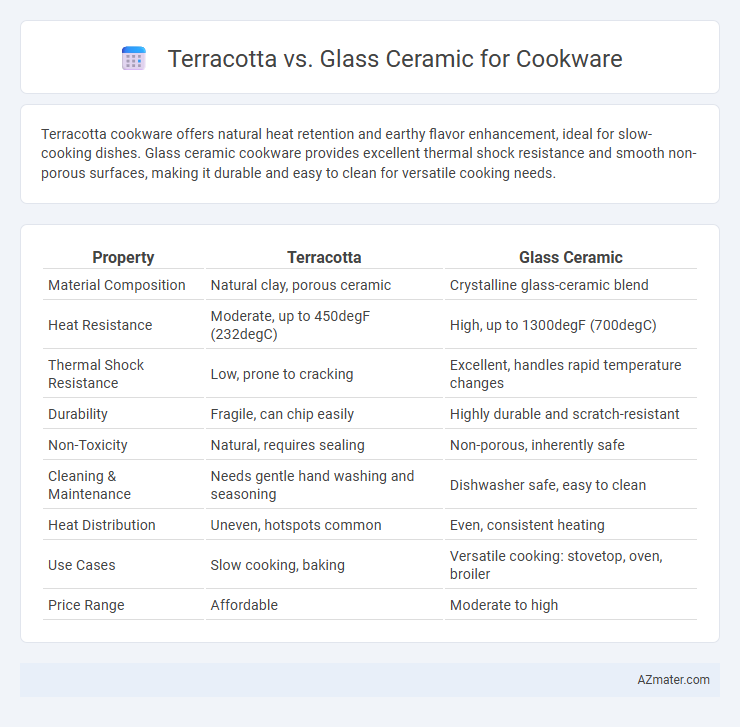Terracotta cookware offers natural heat retention and earthy flavor enhancement, ideal for slow-cooking dishes. Glass ceramic cookware provides excellent thermal shock resistance and smooth non-porous surfaces, making it durable and easy to clean for versatile cooking needs.
Table of Comparison
| Property | Terracotta | Glass Ceramic |
|---|---|---|
| Material Composition | Natural clay, porous ceramic | Crystalline glass-ceramic blend |
| Heat Resistance | Moderate, up to 450degF (232degC) | High, up to 1300degF (700degC) |
| Thermal Shock Resistance | Low, prone to cracking | Excellent, handles rapid temperature changes |
| Durability | Fragile, can chip easily | Highly durable and scratch-resistant |
| Non-Toxicity | Natural, requires sealing | Non-porous, inherently safe |
| Cleaning & Maintenance | Needs gentle hand washing and seasoning | Dishwasher safe, easy to clean |
| Heat Distribution | Uneven, hotspots common | Even, consistent heating |
| Use Cases | Slow cooking, baking | Versatile cooking: stovetop, oven, broiler |
| Price Range | Affordable | Moderate to high |
Introduction to Cookware Materials: Terracotta and Glass Ceramic
Terracotta cookware offers excellent heat retention and natural non-stick properties, making it ideal for slow-cooked meals and traditional recipes. Glass ceramic cookware provides rapid and even heat distribution with high thermal shock resistance, suitable for modern stovetop and oven use. Both materials are prized for their durability and chemical-free cooking surfaces, catering to different culinary techniques and preferences.
Composition and Manufacturing Process
Terracotta cookware is made from natural clay that is shaped and then fired at low temperatures, resulting in porous, breathable vessels that retain heat evenly but require seasoning to prevent cracking. Glass ceramic cookware is produced by melting silica-based materials at extremely high temperatures, followed by a controlled cooling process that creates a non-porous, highly durable surface resistant to thermal shock. The manufacturing of terracotta emphasizes traditional artisanal methods, while glass ceramic relies on advanced industrial techniques to achieve precise thermal and mechanical properties.
Heat Retention and Distribution Properties
Terracotta cookware exhibits excellent heat retention due to its porous clay composition, allowing slow, even heat distribution that helps maintain consistent cooking temperatures. Glass ceramic cookware offers superior heat distribution with rapid heating and cooling, minimizing hot spots ideal for precise temperature control. Terracotta's heat retention suits slow-cooking dishes, while glass ceramic excels in quick, responsive cooking scenarios.
Cooking Performance and Versatility
Terracotta cookware offers excellent heat retention and even cooking, ideal for slow-cooked dishes and stews, but it requires careful maintenance to prevent cracking. Glass ceramic cookware provides rapid, consistent heating and is highly versatile for stovetop and oven use, supporting a wide range of cooking methods from sauteing to baking. Both materials are non-reactive, preserving food flavors, but glass ceramic's durability and ease of cleaning make it more practical for everyday use.
Safety and Health Considerations
Terracotta cookware is known for being naturally non-toxic and free from harmful chemicals such as PFOA and PTFE, making it a safe option for health-conscious users. Glass ceramic cookware offers excellent heat resistance and does not leach chemicals into food, ensuring food safety during cooking at high temperatures. Both materials provide non-reactive surfaces that maintain food purity, but terracotta requires proper seasoning to prevent cracking, while glass ceramic is more resistant to thermal shock and easier to clean.
Maintenance and Cleaning Requirements
Terracotta cookware requires careful hand washing with mild detergent to avoid cracking and should be thoroughly dried to prevent mold growth, while glass ceramic cookware offers the convenience of dishwasher-safe cleaning and resists staining and odor retention. Terracotta's porous nature demands seasoning and periodic oiling to maintain a non-stick surface, whereas glass ceramic surfaces are non-porous and generally easier to maintain without special treatments. Proper maintenance of terracotta prolongs its lifespan by preventing moisture damage, but glass ceramic cookware is more durable with minimal upkeep, making it suitable for busy kitchens.
Durability and Longevity Comparison
Terracotta cookware offers natural heat retention but tends to be more fragile and prone to cracking or chipping over time compared to glass ceramic. Glass ceramic cookware is highly durable, resistant to thermal shock, and can withstand high temperatures without degrading, ensuring longer usability. The longevity of glass ceramic surpasses terracotta, especially in modern kitchens where frequent temperature changes and impacts occur.
Aesthetic Appeal and Design Choices
Terracotta cookware offers a rustic, earthy aesthetic with rich, warm tones that enhance traditional and artisanal kitchen designs. Glass ceramic cookware features a sleek, modern look with smooth surfaces and transparent or opaque finishes, complementing contemporary and minimalist interiors. Both materials provide versatile design choices, but terracotta excels in handcrafted charm while glass ceramic emphasizes clean lines and polished sophistication.
Price Range and Accessibility
Terracotta cookware typically offers an affordable price range, making it accessible for budget-conscious buyers and available in many local markets and specialty stores. In contrast, glass ceramic cookware tends to be more expensive due to advanced manufacturing processes and material quality, often found in premium kitchenware shops or online retailers. Both options provide unique advantages, but terracotta is more widely accessible for everyday use, while glass ceramic targets consumers seeking durability and modern aesthetics at a higher price point.
Choosing the Best Cookware for Your Kitchen
Terracotta cookware offers excellent heat retention and natural, non-toxic properties ideal for slow cooking and simmering traditional dishes. Glass ceramic cookware provides superior thermal shock resistance and even heat distribution, making it perfect for versatile cooking and quick temperature changes. Selecting the best cookware depends on your cooking style; terracotta suits low-and-slow recipes, while glass ceramic excels in everyday use with rapid temperature adjustments.

Infographic: Terracotta vs Glass Ceramic for Cookware
 azmater.com
azmater.com